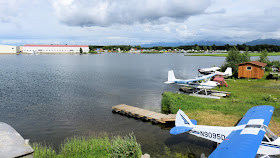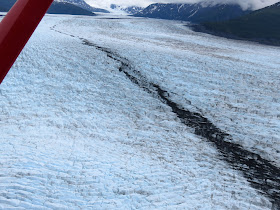Situated on the edge of the world's busiest seaplane base, Lake Hood, the Alaska Aviation Museum is right in the heart of aviation activity in Anchorage, Alaska. After our glacier tour with Rust's, we explored this monument to Alaskan aviation history.
Spoiler alert: there may have been some seaplanes.
Hanging above the entrance hall is this 1929 Travel Air S6000. It operated in Alaska as a passenger and cargo hauler starting in 1939.
I was particularly taken with this gorgeous 1934 WACO YKC on floats.
A key character in early Alaskan aviation was Noel Wien who founded Wien Air Alaska, Alaska's first airline. This fuselage, which strongly resembles some of the Stout designs that led to the Ford Trimotor, is from a Hamilton Metalplane. The type was flown by Noel Wien on the first round trip between North America and Asia, the first American flight into Soviet Russia, and the first aerial crossing of the Bering Sea.
The Bear hopped in this...um...thing...to conduct an imaginary flight.
Hey there, little miss, eyes on the sky! And wipe that smile off your face! Flying is serious business, dammit!
Here's a rare one: a Szekely SR-3 three cylinder radial engine built in Holland, MI. They were not exactly renowned for reliability, which is probably why I had never heard of Szekely engines until I found one in Alaska.
The oldest aircraft in the collection is this 1928 Stearman C2B. I confess that I did not recognize it as a Stearman at first because it lacked the distinctive gear legs of the later (1934) Stearman Kaydet. In 1932, it was involved in the first landing and rescue on Denali.
This engine is from the recovered wreck of Alaskan aviation pioneer Steve Mills, who crashed his Bellanca Pacemaker while flying a fishing charter in 1936. It serves as a reminder that the tremendous advantages conferred to Alaska by aviation came at a high price for early pioneers in flight.
Goofy interlude with The Bear! Now, back to the aircraft.
This 1941 Stinson L-1 Vigilant served as an observation aircraft during WWII and operated from Fairbanks and Anchorage. Though the museum claims that it is the only surviving example of the approximately 400 L-1s built, there appear to be a small handful of them scattered around the United States.
What is particularly unique about this liaison aircraft, which differentiates it from Stinson's far more common L-5 Sentinel, is the outward cant of its windows to facilitate ground observation.
The Bear came in hot and greased the landing on Runway 8.
This 1974 F-15 Eagle served at Elmendorf Air Base in Anchorage before it came to museum.
Grumman made a series of twin-engined, amphibious flying boats of different sizes with the smallest being the Widgeon. The history of this 1943 Widgeon is not well known.
This is a Boeing 737 known as a Combi or Mud Hen, built as a combination passenger and cargo ship for maximum versatility. It flew for Alaska Airlines from 1981 to 2007. It is normally open to museum visitors, but was closed up because of a rainstorm that morning.
The Bear was intrigued by this 1955 Piper Super Cub. Here she is looking "super" with the Super Cub.
Maybe it's time to land when your passengers look like they were inspired by Edvard Munch?
Seaplane trainer?
The Goose was the next larger amphibian built by Grumman in the 1940s. This was the same type of aircraft featured in Tales of the Gold Monkey, an ABC adventure series that aired from 1982 to 1983. I loved that show, but no else seems to remember it (which probably explains why only a single season was ever made). This Goose started its service with the Navy in 1944, transitioned to the U.S. Fish & Wildlife Service in Alaska in 1956, then was reassigned to the Department of the Interior from 1974 until 1994. This airplane performed public service in Alaska for an astounding 38 years.
This is the wreckage of the Douglas World Cruiser Seattle, built for a US Army project to circumnavigate the globe by air. Four airplanes, the Seattle, Boston, Chicago, and New Orleans departed on their journey in April 1924 from Seattle, Washington. The Seattle, the lead ship, crashed in Alaska 24 days later. Pictured here are the remains of the propeller and the aircraft's Liberty L-12 engine. The Boston crashed in the Atlantic and was never recovered. A prototype World Cruiser, rechristened the Boston II, joined the Chicago and the New Orleans to complete the flight by returning to Seattle in September after 371 hours in flight.
A beautiful 1944 Stinson Reliant.
A Beech 18 on floats!
This 1944 Beech 18 is displayed as configured during its time as a Search and Rescue aircraft at Elmendorf AFB in Anchorage.
This 1943 Consolidated PBY Catalina is truly a magnificent wreck of an aircraft.
When we were finished touring the museum, we lingered on the grounds to absorb the activity at Lake Hood Seaplane Base.
We even caught one of Rust's Beavers departing the water.
The Alaska Aviation Museum has some interesting, unique aviation artifacts and great stories to tell about aviation in The Last Frontier.
Pages
▼
Wednesday, July 11, 2018
Alaska 2018: Seaplane Excursion
Conundrum and Solution
While planning our vacation to Alaska, we debated about an inland trip to see Denali, the tallest peak in North America that reaches 20,310 feet above sea level. My concern was The Bear. A land excursion to Denali would require two days of travel to get there and back again. It seemed like a lot to ask an eleven year old to do. Because the mountain is often obscured by clouds, only a fraction of those who journey to see it actually do. The solution to that is to schedule more time in Denali in hopes of catching good weather, but I had limited vacation time available.
Our solution was to book a Denali flightseeing trip with Rust's Flying Service. We would depart Anchorage in a seaplane (a first time for all three of us) to see the mountain, returning the same day. If weather hid the mountain from us, the trip likely would not go and we could do something else. It compressed the timing and eliminated the scenario of extensive travel with little payoff.
On the morning of our excursion, Rust's called to say that the weather was terrible in the direction of Denali and that the flight was cancelled. However, they offered an alternative seaplane tour of the Knik Glacier northeast of Anchorage. We accepted the swap and Rust's picked us up right at our hotel in Anchorage, the Voyager Inn.
Lake Hood
Rust's is based at Lake Hood (LHD, PALH), which purports to be the world's busiest seaplane base with an average of 190 operations per day. Lake Hood is directly adjacent to Ted Stevens Anchorage International Airport, whose tower controllers provide tower services to Lake Hood.
I was pleased to find this stained glass seaplane in Rust's lobby. Now that's what I call art!
When we arrived at Rust's, I immediately spotted this de Havilland Beaver being prepped for flight.
Was I finally going to fly in a Beaver?
Nope.
Instead, our pilot Mike directed us to the Cessna 206 beside it. Oh well. I flew right seat, Kristy and another passenger (who spent the whole flight inexplicably playing with his phone) were in the second row, and The Bear was on her own in the third row.
I looked wistfully at the Beaver as we pulled away from the dock.
Lake Hood offers sufficient take off and landing directions that taxi diagrams actually exist for it. This one was created by the team at ForeFlight, but a similar diagram can be found in the FAA Chart Supplement (A/FD).
The take off was smooth from the water as the large Cessna dragged us and those big floats through the air. Mike navigated the airspace around Ted Stevens International, resulting in a low fly-over of Anchorage.
We flew east toward the Chugach Mountains, then turned northeast toward Palmer.
The Chugach Mountains seemed to tower over our altitude as we flew low to avoid the approach corridor to Ted Stevens.
Knik and Colony Glaciers
We followed the Knik River into the mountains, observing several moose foraging for food on their spindly legs.
In the distance, the Knik Glacier was distinctively marked with a huge moraine that ran down the center of the glacier.
The Knik River appeared gray from glacial silt.
We passed rather close to clouds at times. "Class G airspace," Mike indicated preemptively before I could ask about cloud clearances. He had noted my Alton Bay Ice Runway hat and surmised that I was a pilot.
From over the end of the Knik Glacier, we could see Lake George and the Colony Glacier, a smaller glacier that feeds into the same valley as the Knik.
Interesting things always happen at the edges.
Sometimes the headwaters of the Knik River are physically blocked by ice floes.
I am fascinated by glacier morphology. There is a great deal of variation over the surface.
We flew far enough along the Knik Glacier to see the origin of its prominent moraine.
We made a brief excursion to the Colony Glacier as well.
When we returned to the Knik, we focused on the massive icebergs that had calved from the face of the glacier. These were no tiny "bergie bits".
After being so used to shooting photos from my Warrior, I became frustrated by how often the Cessna's strut ruined my shots.
It was a thrill to zip along low over the glacier in the burly Cessna.
This was our final broad view of the Knik. Mike indicated that the Knik Glacier was the location for some of the Star Trek VI scenes when Kirk and McCoy escaped the Klingon prison Rura Penthe.
As we returned to Anchorage, Mike explained about the dangers of mud flats like the one below us. Because water depth varies significantly with the tide, people sometimes get stuck in the mud only to drown when the tide rolls in. It seemed like a crummy way to die.
En route to Lake Hood, I had Ted Stevens International Airport in sight well before I spotted the smaller seaplane base alongside.
On final approach and cleared to land by tower, the rain started. I was uncomfortable by what looked to me like a short landing distance. The landing was surprisingly smooth and I was amazed (and relieved) by how rapidly the 206 decelerated on its floats.
Returning to Rust's, I silently coveted the Beaver again.
 |
| Photo by Kristy |
Naturally, The Bear immediately found the airport dog and made a new friend. We thoroughly enjoyed our glacier tour by seaplane and the entire experience at Lake Hood was exciting for those of us used to wheeled airplanes.
The Mountain
Though our goal to see Denali by air was not met that day, it was met the next day in the most surprising way. We were riding the Alaska Railroad back into Anchorage after a day trip to Seward when we sighted the mountain 133 miles away. Our tour guide indicated that the air is only clear enough a couple of days each year for Denali to be visible from Anchorage. Evidently, July 11 was one of those days.





























































































